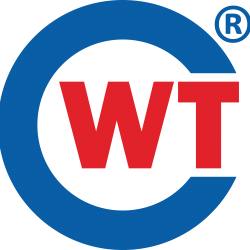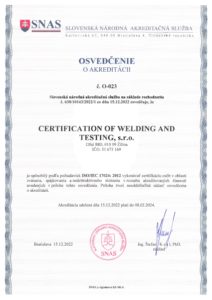C-WT Certification Body for persons is accredited in accordance with requirements of standard EN ISO/IEC 17024: 2012 and provides personnel certification services in the field of non-destructive testing (NDT) and welding.
NDT – non-destructive testing according to EN ISO 9712:
VT – Visual testing – Level 1, 2, 3
PT – Penetrant testing – Level 1, 2, 3
MT – Magnetic testing – Level 1, 2, 3
RT-F – Radiographic testing – film radiography – Level 1, 2, 3
RT-D – Radiographic testing – digital and computed radiography – Level 1, 2, 3
UT – Ultrasonic testing – Level 1, 2, 3
UT-TOFD – Ultrasonic testing – Time of flight diffraction TOFD – Level 1, 2, 3
UT-PA – Ultrasonic testing – Phased Array – Level 1, 2, 3
ET – Eddy current testing – Level 1, 2, 3
LT-P – Leak testing – pressure method – Level 1, 2, 3
LT-TG – Leak testing – tracer gas method – Level 1, 2, 3
VT-ThP – Visual testing of thermoplastics welded joints – Level 1, 2
RT-FI – Radiographic film interpretation – Level 2
RT-DI – Radiographic digital image interpretation – Level 2
RT-FDI – Radiographic film and digital image interpretation – Level 2
UT-T – Ultrasonic testing – thickness measurement – Level 2
Welding:
Qualification examination of welders
Plastics welding personnel, Thermoplastics welding assemblies
Qualification testing of brazers / brazing operators
Welding operators / weld setters for mechanized and automatic welding


Declaration of impartiality:
Within the activities of the certification body is applied the non-discriminatory management method. Certification body is not dependent on other companies influencing the results of the certification process. The certification body is fully responsible for the decisions under certification, including the granting, maintenance, recertification, extension and narrowing of the scope of certification, and the suspension or withdrawal of the certificate. In carrying out activities related to the certification of persons, the certification body ensures objectivity, declares that it is impartial and controls the conflict of interest. In the certification process, the certification body will deal with identification, analysis, and eventual occurrence as well as documentation of potential conflicts of interest in the certification process, including relationship-driven conflicts. If the relationship would create risks of impartiality, it is essential that the certification body subsequently document it and propose ways to eliminate or minimize its impact.



